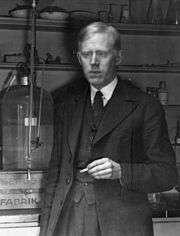Odd Hassel
| Odd Hassel | |
|---|---|
|
Odd Hassel, c.1935 | |
| Born |
17 May 1897 Kristiania, Norway |
| Died |
11 May 1981 (aged 83) Never married |
| Nationality | Norway |
| Fields | Physical chemistry |
| Alma mater | University of Oslo |
| Notable awards | Nobel Prize in Chemistry (1969) |
Odd Hassel (17 May 1897 – 11 May 1981) was a Norwegian physical chemist and Nobel Laureate.
Biography
Born in Kristiania (now Oslo), his parents were Ernst Hassel, a gynaecologist, and Mathilde Klaveness. In 1915, he entered the University of Oslo where he studied mathematics, physics and chemistry, and graduated in 1920. After taking a year off from studying, he went to Munich, Germany to work in the laboratory of Professor Kasimir Fajans.[1] His work there led to the detection of absorption indicators. After moving to Berlin, he worked at the Kaiser Wilhelm Institute, where he began to do research on X-ray crystallography.[2] He furthered his research with a Rockefeller Fellowship, obtained with the help of Fritz Haber. In 1924, he obtained his PhD from the Berlin University, before moving to his alma mater, the University of Oslo, where he worked from 1925 through 1964. He became a professor in 1934.[3]
His work was interrupted in October, 1943 when he and other university staff members were arrested by the Nasjonal Samling and handed over to the occupation authorities. He spent time in several detention camps, until he was released in November, 1944.[4]
In addition to the Nobel, he also received the Guldberg-Waage Medal from the Norwegian Chemical Society and the Gunnerus Medal from the Royal Norwegian Society of Science and Letters, both in 1964. An annual lecture, named in his honor, is given at the University of Oslo.
Work
Hassel originally focused on inorganic chemistry, but beginning in 1930 his work concentrated on problems connected with molecular structure, particularly the structure of cyclohexane and its derivatives. He introduced the Norwegian scientific community to the concepts of the electric dipole moments and electron diffraction. The work for which he is best known established the three-dimensionality of molecular geometry. He focused his research on ring-shaped carbon molecules, which he suspected filled three dimensions instead of two, the common belief of the time. By using the number of bonds between the carbon and hydrogen atoms, Hassel demonstrated the impossibility of the molecules existing on only one plane. This discovery led to his being awarded the Nobel Prize in Chemistry for 1969.
References
- ↑ Candid Science III: More Conversations with Famous Chemists, Istvan Hargittai, Magdolna Hargittai, Imperial College Press, 2003.
- ↑ Odd Hassel biography bookrags.com
- ↑ Odd Hassel - The Nobel Prize in Chemistry 1969, nobelprize.org
- ↑ Ottosen, Kristian, ed. (2004). Nordmenn i fangenskap 1940–1945 (in Norwegian) (2nd ed.). Oslo: Universitetsforlaget. p. 289. ISBN 82-15-00288-9.
Further reading
- Oakes, E. (2002). A to Z of Chemists. Facts on File Science library : Notable scientists. New York: VB Hermitage. ISBN 0-8160-4579-8.
External links
- Hassel's Nobel Foundation biography
- Hassel's Nobel Lecture Structural Aspects of Interatomic Charge-Transfer Bonding

